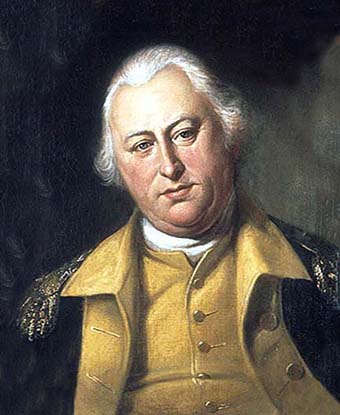Last updated: March 6, 2025
Person
Benjamin Lincoln

National Park Service (Independence National Historical Park)
Benjamin Lincoln, major general in the Continental Army, was one of the few individuals present at the three major surrenders of the American Revolution: Saratoga, Charleston, and Yorktown. He followed his military career with public service at the state and federal level.
Lincoln was born on January 24, 1733, in Hingham, Massachusetts. He attended local schools and then established his own farm. Elected town clerk in 1757, he gradually became prominent in the colony's militia and politics. By 1772, he had achieved the rank of lieutenant colonel and had been elected to the colonial legislature.
He rose to prominence in the Seven Years' War where he gained experience in military planning and organization. He later served as the secretary of the provincial assembly that replaced the colonial legislature in defiance of the Boston Port Bill.
In February 1776, the Massachusetts legislature appointed him a major general of militia. His service in the New York campaign, especially his command of militia soldiers who bought General Washington's army time to retreat to White Plains, New York, earned him praise and recognition. Acting on Washington's recommendation, the Continental Congress appointed him a major general in the Continental Army on February 14, 1777.
Lincoln's first combat experience as a major general in the Continental Army came in the Battle of Bound Brook on April 13, 1777, an engagement in which the British and Hessians attempted to surprise a portion of the Continental Army at the end of the winter encampment. Defeated by British General Cornwallis, Lincoln successfuly led his men away from capture. Lincoln received orders from Washington in July 1777 to travel to upstate New York and aid in the defense of the state from British General Burgoyne's march down the Hudson River.
Lincoln's task was to raise the New England militia and harass British supply lines in the vicinity of Fort Ticonderoga. His command had some success but was weakened by the lack of cooperation from leading New England militia generals like John Stark. Maj. Gen. Horatio Gates, commander of the Northern Department, ordered Lincoln to join his forces.
Lincoln arrived after the Battle of Freeman's Farm. Lincoln's militia played no role in the Battle of Bemis Heights as they were on the other side of the river from the decisive Patriot victory in which then-Patriot General Benedict Arnold won fame for his bravery. In a skirmish following the battle, Lincoln's ankle was shattered by a British musket ball while his men defended a ford over the Hudson River. He spent several months recovering at his home in Hingham. The injury left his affected leg two inches shorter than the other, and the danger of infection loomed.
The Continental Congress, impressed with Lincoln's service, chose him to replace Maj. Gen. Robert Howe as commander of the Southern Department in September 1778. Lincoln arrived in Charleston to take command in December, nearly coinciding with the British capture of Savannah, Georgia. Lincoln wanted to drive the British out of Georgia, but his actions in Georgia exposed South Carolina to attack.
His spring 1779 campaign against the British in Georgia, marching on Augusta, prompted British General Augustine Prevost to attack Charleston. The British devastated Patriot properties in the Lowcountry near Charleston, threatening the city, and forced Lincoln's army to return to South Carolina. Lincoln complained to General William Moultrie, "it appears...that I have lost the confidence of the people."1 Contemplating resignation, Moultrie and Governor Rutledge convinced Lincoln to remain. Lincoln then led American forces in the disastrous Franco-American Siege of Savannah in October 1779, in which the Patriots and French suffered almost 1,000 casualties. This largely forgotten battle was one of the war's bloodiest and also significant for the over 500 free black Haitian soldiers in the French command.
Following this defeat, Lincoln then presided over the largest defeat of American forces during the American Revolution, the surrender of Charleston and 5,000 soldiers. He decided to hold Charleston against a combined British army and navy expedition, commanded by General Sir Henry Clinton and Admiral Marriot Arbuthnot. After a siege of six weeks on the peninsula of Charleston, without effective support from the Continental Navy, Lincoln capitulated on May 12, 1780.
Exchanged in November 1780, Lincoln served as second in command to Washington during the Yorktown campaign. Feigning illness, British General Cornwallis declined to attend the surrender ceremony. His second in command, Brig. Gen. Charles O'Hara, attempted to surrender his sword to Washington. Washington declined and motioned toward Lincoln, who accepted the sword.
During the last years of the American Revolution, Lincoln served as the first Secretary at War, under the Congress of the Confederation, from 1781 - 83. In 1787, he was a member of the Massachusetts state convention that ratified the US Constitution. He later held various positions in the Massachusetts government and, also as a reward for his Federalist politics, served as the Collector of the Port of Boston, a lucrative federal appointment he held for about twenty years until his retirement in 1809.
Footnotes
- William Moultrie, Memoirs of the American Revolution : so far as it related to the states of North and South Carolina, and Georgia (New York: D. Longworth, 1802), 477.
Sources
"Lincoln, Benjamin." South Carolina Encyclopedia. https://www.scencyclopedia.org/sce/entries/lincoln-benjamin/.
Moultrie, William. Memoirs of the American Revolution : so far as it related to the states of North and South Carolina, and Georgia. New York: D. Longworth, 1802.
Shipton, Clifford K. "Benjamin Lincoln: Old Reliable." George Washington’s Generals and Opponents: Their Exploits and Leadership. Edited by George A. Billias. Volume I. New York: De Capo Press, reprint 1994, 193-211.
